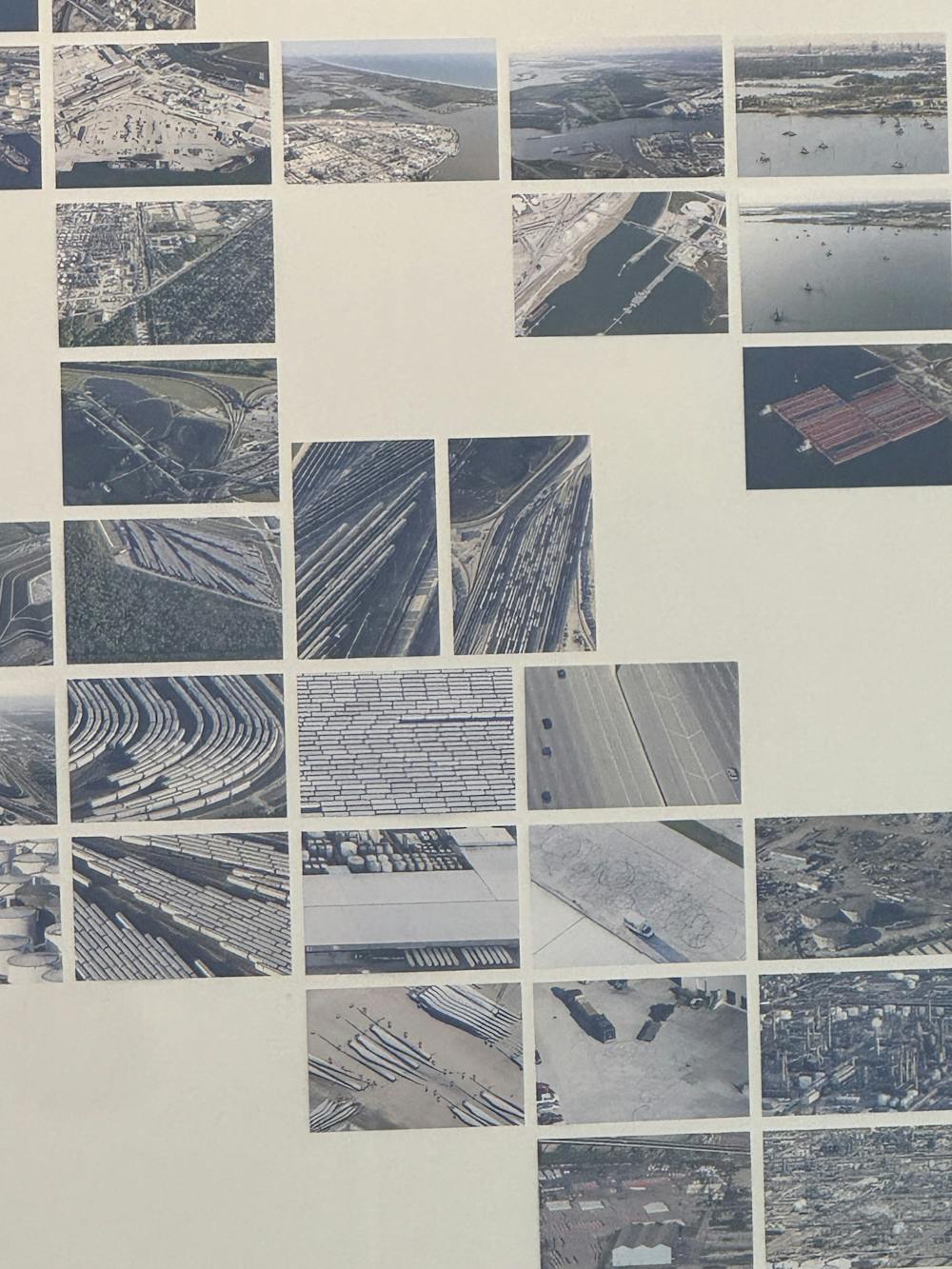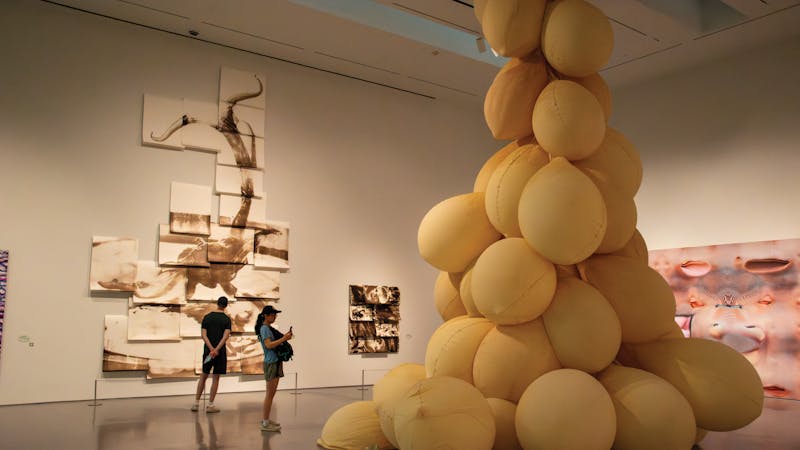Rice Architecture Presents "Iwan Baan: The Notational Surface" — Rethinking Environment, Change and Planet

“Iwan Baan: The Notational Surface” will be on view at Cannady Hall from Sept. 3 to Oct.25, 2025. Arman Saxena / Thresher
Houston’s tangle of overpasses has grown so massive that a single interchange covers as much area as Siena, Italy. Capturing the city’s “spaghetti bowl” highways from above, Iwan Baan’s camera renders its curves and intersections into a peculiar tactile language. The Rice School of Architecture launched the opening of “Iwan Baan: The Notational Surface,” an exhibition by the acclaimed Dutch photographer, on Sept. 3. Presented as part of the school’s new curatorial program, the exhibition is currently on display at Cannady Hall through Oct. 25.
William Ward Watkin Dean of the School of Architecture Igor Marjanović said the new program aims to use Cannady Hall’s gallery space to expand how architectural ideas are communicated. This is the third exhibition in the space, and the second season of the curatorial program following last year’s exhibition by Angela Chen, a former lecturer in the Department of Art.
“Our goal with this program is to use the lens of architecture to see the world differently, not just buildings, but the spaces between them, the infrastructures and landscapes that shape our lives,” Marjanović said.
Baan’s five-year project captures Houston from street to sky, exposing the city’s infrastructure, vulnerabilities and complexity.
The exhibition is organized around four themes — downtown architecture, highway intersections, suburban developments and industrial zones — reflecting Houston’s unique urban condition, where the absence of zoning laws allows different forms of development to exist side by side. It was developed in collaboration with graphic design studio Experimental Jetset (Amsterdam) and exhibition designers Departamento del Distrito (Houston/Mexico City). Spanning two floors of Cannady Hall, the show moves from the intimate scale of street life to sweeping aerial views of Houston’s oil infrastructure, intermodal networks and suburban sprawl.
Nathan Friedman, professor in the practice of architecture and a partner at Departamento del Distrito, helped shape the exhibition’s spatial layout and presentation. Friedman said the design aimed to emphasize the archive’s breadth while also highlighting the power of Baan’s high-resolution images to be experienced at multiple scales.
“We wanted the ground floor to convey the diversity of Baan’s documentation, so visitors encounter a wide selection of 200 images from a larger body of 3,000,” Friedman said. “On the second floor, we shifted focus, enlarging 30 photographs to show how urban conditions overlap and bleed into one another. The result is a sense of adjacency, where seemingly separate worlds, like residential neighborhoods and industrial zones, are revealed as closely connected.”
For students, the exhibition’s scale offers an especially striking entry point. Katrina Lee, an architecture student, said she was surprised by the immensity of both the photographs and the city they portray.
“What stood out to me most was the sheer scale. The infrastructure and industrial zones are so vast they can’t even be captured within a single frame,” said Lee, a Sid Richardson College junior. “I also discovered parts of Houston I had never seen before, which really showed me just how extensive and industrial the city is.”
Beyond the photographs themselves, the exhibition creates a spatial experience that challenges visitors to see the city and the forces that shape it through a new lens. Friedman said the design intentionally breaks from traditional gallery formats to reframe how visitors encounter the images.
He explained that the second-floor installation used lightweight aluminum frames without glass, reducing glare and inviting viewers to see the photos from unexpected angles. “Each frame was designed as if mid-liftoff,” Friedman said, “turning the display into an architectural experience.”
Marjanović added that the design “turns the exhibition itself into an architectural experience, not just a display of images.”
This immersive design translated into a more embodied way of experiencing the city through Baan’s images. Titan Chen, an architecture student, said the exhibition’s unusual perspectives encouraged him to connect physically with the work.
“What struck me was how the design asks you to view the images from positions you wouldn’t normally take, looking up from the floor or lying back to see a photograph overhead,” said Chen, a McMurtry College junior. “At one point, lying down beneath a tilted frame, I even lost my sense of direction for a moment. That disorientation became part of the experience, reminding me that architecture is not only about what you see but how your body engages with space.”
Beyond its visual impact, the exhibition also serves an educational purpose, offering students a chance to holistically engage with Houston through both architectural and comparative lenses. Marjanović emphasized how Baan’s work provides context for students designing projects within the city.
“They can recognize areas they’ve visited while also encountering neighborhoods they might not know,” Marjanović said. “At the same time, Baan is one of the most important architectural photographers working today, so Houston is now positioned alongside other cities he has documented around the world. That creates an opportunity to ask what parallels exist and what makes Houston unique.”
Grace Xu, an architecture student, said both Baan’s lecture and the exhibition deepened her understanding of Houston’s built environment, particularly through its contrast with Europe’s highways.
“In Italy, roads weave through the landscape and adapt to it,” said Xu, a Wiess College junior. “While in Houston, the highways dominate as an artificial system that reshapes everything around them. That point became even more powerful when I encountered the large aerial photograph suspended in Cannady Hall. Taken from a helicopter, it was displayed at an incline so that, even while looking upward, I felt as if I were looking down from the aircraft into the city.”
Marjanović said the exhibition emerged from a conversation with Baan about creating not only a distinctive educational experience for students but also connecting with the wider Houston community. He emphasized that the collaborative process behind the exhibition mirrors the very nature of architecture as a discipline.
“This has been a truly collaborative effort between the artist, designers, architects, graphic team and editorial team,” Marjanović said. “Architecture is never the work of a single author, and Baan himself embodies that collaborative spirit.”
For Friedman, the project also highlights how Houston’s complexity speaks to both local and global conditions.
“Many of us at Rice aren’t native Houstonians, and this exhibition offers a panoramic view of the city’s layers that reflects broader urban questions around the world,” Friedman said. “At the School of Architecture, we teach students to see architecture not as isolated buildings but as part of larger systems, from supply chains to energy networks to communities.”
Reflecting on the exhibition’s broader message, Marjanović said he hopes visitors leave with a heightened awareness of Houston’s vulnerabilities as well as its possibilities.
“I want viewers to look at these images not just for what they depict, but for what they suggest about Houston’s future,” Marjanović said. “The city’s refineries and infrastructure sit in close proximity to our daily lives, a reminder of both our dependence on and our exposure to risk.”
That tension between beauty and fragility also resonated with members of Houston’s design community. Natalye Appel, founding principal of Natalye Appel + Associates Architects, observed that the exhibition raises questions that extend beyond the frame.
“An exhibit like this makes you wonder about the daily lives of the people within these beautiful swirling freeways and ship channels,” Appel said. “It’s a stunning display of abstract beauty, but what about the problems in a city like this? What about the lives of its people? That’s the human story it evokes for viewers everywhere.”
Marjanović added that the exhibition is part of the Houston Archive Project, an initiative launched in 2024 to commission new photographic work documenting the city’s rapid transformation. The project, he said, serves as a kind of time capsule, situating Houston’s urban conditions within larger planetary systems. Baan’s images will be preserved in Rice’s Woodson Research Center and published in the School of Architecture’s annual journal Sphere, which will include a series of postcards presenting Houston at this particular moment in time.
Summing up the exhibition in three words, Marjanović pointed to its global relevance.
“Environment, Change, Planet — these images show how Houston is shifting, and why it matters everywhere,” Marjanović said. “A reminder that Houston’s story is also the world’s.”
Iwan Baan: The Notational Surface" is on view through Oct. 25 at William T. Cannady Hall.
More from The Rice Thresher

Moody Center’s new exhibit blurs the line between body and machine
Swelling latex sculptures, inspired by placentas and umbilical cords have taken up residence in the Moody Center for the Arts. The Barcelona-based artist Eva Fàbregas describes her pieces as forms that grow from “the guts of the architecture,” inflating and wrinkling as if they were alive.

Rice students bid farewell to Bayou Bucket series
For the first time in almost 30 years, Rice students and their families gathered in the academic quad for a pep rally on Friday. With the annual game against the University of Houston not renewed for at least another five years, this could be many students’ last Bayou Bucket clash between the two Houston universities.

Review: On “Live Laugh Love,” Earl Sweatshirt is finally at peace
Peace is both a state and a farewell. On “Live Laugh Love,” Earl Sweatshirt sounds like an artist who has finally found both. For a decade, Earl has been hip-hop’s resident pessimist, rapping in hushed tones about absence, grief and alienation.

Please note All comments are eligible for publication by The Rice Thresher.